Cassowaries live in the rainforests of Queensland. But despite their size, they're not easy to find, explains Steve Portugal.
There can be few more imposing sights in nature than an adult cassowary. Standing nearly 2m tall and weighing up to 50kg, it is no mystery why these large, flightless birds, found in north-eastern Australia and Papua New Guinea, have long conjured up comparisons to prehistoric dinosaurs.
As a boy, I always dreamed of seeing one in the wild but, growing up in the 1980s, Australia seemed unimaginably exotic and far away.
The opportunity for that childhood dream to become reality landed in February 2023, when I was offered a work trip to Australia. Finally, I had my chance to seek cassowaries in the wild – and I jumped at it.
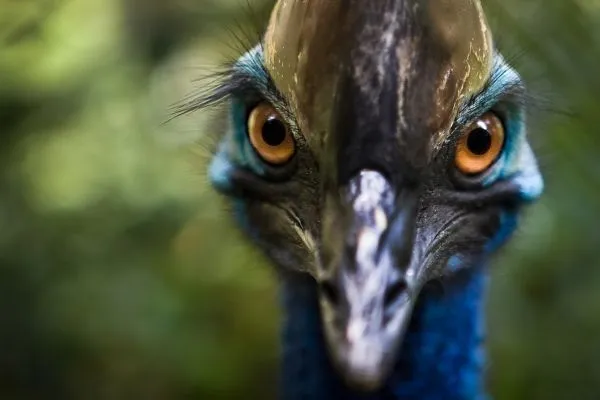
How many species of cassowary are there?
The magnificent name ‘cassowary’ originates from the Papuan for ‘horned’ (kasu) and ‘head’ (weri), a reference to its casque.
The species found in the tropical rainforests of north-eastern Queensland is the southern cassowary. It can also be found in Papua New Guinea, along with its cousin, the northern cassowary and a third species, the dwarf cassowary.
Where do cassowary live in Australia?
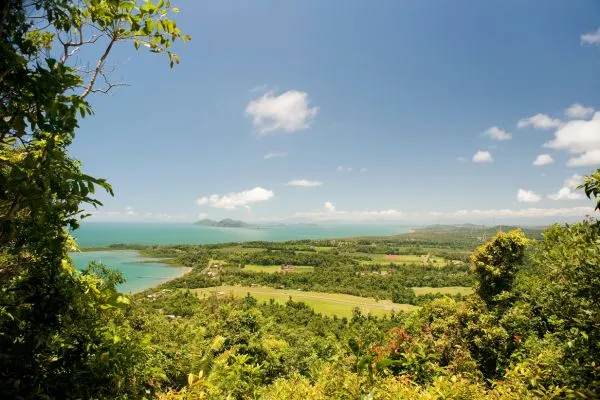
The focus of my quest was the beautiful – and aptly named – Mission Beach. This locality with a spectacular stretch of sand sits on the Cassowary Coast, where it is surrounded by the Wet Tropics forests and looks out eastwards to the Great Barrier Reef. It is the only place in the world where tropical rainforest collides with coral reef, and images of enormous cassowaries foraging on idyllic beaches have become synonymous with the area as a whole.
Due to habitat destruction and urban development, the rainforests at Mission Beach are almost entirely isolated from the wider rainforest habitat. Despite this, the area is home to one of Australia’s largest populations of cassowaries and they have survived on these shores for 60 million years.
So, it was there that I headed, with enthusiasm, to try and connect with these charismatic feathered giants. It would not be easy. I had less than three days, and as if tracking down this elusive bird in such a small amount of time wasn’t challenging enough, I would be covering the entire area on foot.
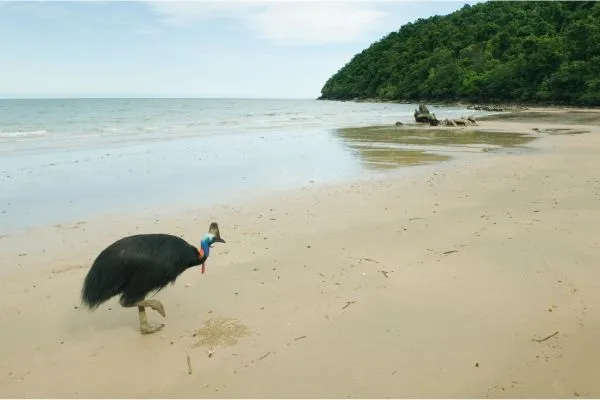
In addition to their impressive size and weight, cassowaries possess a host of other intriguing features. They belong to a group called the ratites, which includes their close relatives the ostriches, emus and rheas, all of which are equally renowned for their colossal size.
Unlike most birds, cassowaries show a role-reversal when it comes to breeding, with the males undertaking the 50-day incubation duty and rearing the young. But perhaps what they are most famous – or infamous – for is being, allegedly, the world’s most dangerous bird.
Why are cassowary dangerous?
It’s not hard to see why cassowaries stake a claim to this dubious honour. They are equipped with 15cm claws on their middle toes, primarily used as a defence against predators such as dingos, pythons and birds of prey, which target young birds. They can run at speeds of 50kph, clear 2m when jumping, and deliver a mean kick.

In addition, legends about their voracity abound. “How worried should I be?”, I wondered, as I prepared to roam the rainforest alone, seeking out the very creatures that most other humans would probably prefer to avoid?
Naturally, whether the cassowary deserves its reputation is debatable. In Australia, most animal-related deaths are caused, not by cassowaries, but by horses, followed by cows and dogs. Indeed, only one person in the entire world has been confirmed to have been killed by a wild cassowary – in 1926, a 16-year-old boy died after attacking an individual he found on his property. Certainly, it soon became clear that the residents of Mission Beach do not live in fear of cassowaries. For starters, arrivals to the bus station are welcomed by a large wooden cassowary, while umpteen shops, roads and buildings bear the bird’s name.
What do cassowary eat?
As the primary distributor of seeds in rainforests, cassowaries are a keystone species in Australia, known to eat up to 238 different types of plant. Despite their formidable appearance, these are shy, reclusive birds, shunning the company of their own kind in favour of a solitary lifestyle, and I did wonder if I was looking for the proverbial needle in a haystack.
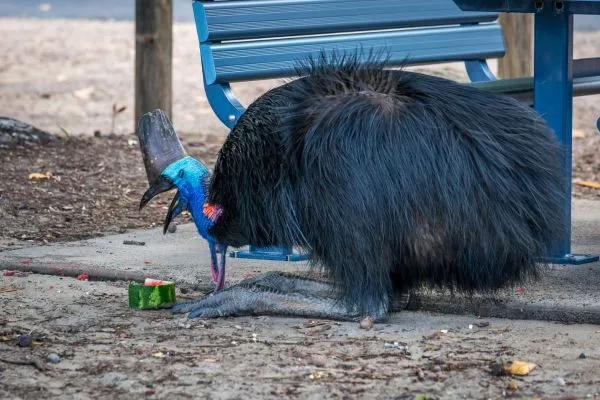
Each bird defends a territory of around one square kilometre, confining its daily movements within this defined home range. They move along regular pathways between roost sites and fruiting trees and can be very inconspicuous and hard to spot within the complex, dense habitat of a rainforest.
Local cassowary expert Ingrid Marker gave me some advice on where to seek out the birds, and my main area of focus was a 10km trail through the rainforest.
Day one started at 5am, and the astonishing sounds and smells I encountered when entering the rainforest took my breath away. I was surrounded by kingfishers and lace monitor lizards and serenaded by the squawks of parrots and the rustle of leaf litter as rat kangaroos foraged for fungi and fruit.
But despite my best efforts and the 33,000 steps logged on my phone, my first foray for cassowaries yielded only dung and prints.
Why is the southern cassowary endangered?
That night, unable to sleep for the mosquito bites sustained during my hike, I mulled over a comment a local had made to me in the pub. “Your best bet is the roads,” he’d advised. I was mindful of the troubled relationship between cassowaries and motorists.

The two biggest direct threats to the birds at Mission Beach are from cars (from 2001-2005, 76 per cent of the cassowary deaths recorded at Mission Beach were due to road collisions) and dogs. These dangers, coupled with habitat loss and competition over resources from a large population of feral pigs, have caused substantial declines in the region. Recent estimates suggest Australia’s southern population of cassowaries may have declined to just 800-1,000 individuals. They take a long time to reach breeding age and can live 50 years; every individual lost through roadkill significantly impacts the population.
With a backpack filled with food and water, I headed off on day two of my cassowary quest. A complete repeat of yesterday’s walk yielded precisely zero birds. But as I exited the rainforest, three hours of daylight remained, and I made the snap decision to head to Carmoo, a small estate a few kilometres away. I had seen photos of cassowaries strutting among the gardens of the large houses there, and decided it might offer my best chance of a sighting. The road to Carmoo is long and straight, and I gratefully accepted a lift from a passing motorist. I was full of optimism, but my walk there proved as fruitless as the last.
Conflict often arises when wildlife comes into regular contact with people, and these birds are a case in point. On the 20th March 2006, Cyclone Larry brought devastation to the region. Winds reached speeds of over 300kph, and properties and structures were destroyed. No human fatalities were reported, but 35 per cent of the cassowary population was killed. The survivors, with little to no shelter or food, ventured into urban areas, taking advantage of food offered by local people to save the birds from starvation. This supplementary feeding persisted for many years, and the local birds became very accustomed to associating certain houses and people with easy meals.
There’s no doubt that this relief effort saved the population from extinction, yet certain individuals started behaving aggressively towards humans when food was not provided. With conflict escalating, a feeding ban was imposed, carrying the hefty penalty of a $5,000 fine.
Are cassowaries easy to find?
With one hour left before sunset, I headed to the caravan parks of South Mission Beach, a popular haunt for cassowaries, which solicit handouts from barbecues. A passing taxi saved me the 9km walk, and the driver, Jane, told me that she regularly sees cassowaries in her garden. She phoned her children to see if any birds were present, but alas, there weren’t. Jane also told me that the rubbish tip at South Mission Beach was a cassowary hotspot and dropped me off there, promising to pick me up later.
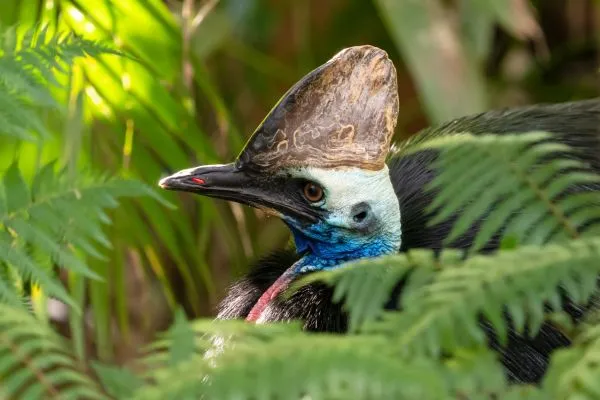
Another lengthy walkabout and still the birds eluded me. It was getting dark so, after two consolatory ice creams, I headed back to the rubbish tip and dozed off on the pavement while waiting for my lift. When Jane’s headlights roused me, I awoke to the rather odd view of a wallaby licking my trainers. Perhaps, given how much I’d been sweating, it viewed me as a mobile salt-lick.
The drive back to Mission Beach was incredibly insightful. Jane explained how, despite the fines, people still fed cassowaries in their gardens. A local guest house even offered paid photography opportunities in its garden, with the birds fed solely for this purpose. Clearly, the message wasn’t getting through. More cassowary tales abounded in the pub, where locals recounted stories from across the years. Not everyone liked the birds, however; one young man even wished they weren’t there at all. He found the speeding restrictions designed to protect the birds frustrating, though admitted he largely ignored them anyway.
I awoke at 4:40am following the strangest dream, in which I was making cassowary sock puppets. I really did have cassowaries on the brain. It was still dark and too early to leave, so I sat on the beach and watched the sunrise. I reminded myself that even if I failed in my quest, Mission Beach is a magical place, and I was a very lucky man to have experienced it.
Then, my phone pinged. It was Ingrid, the cassowary expert, enquiring as to my success. As consolation for the fact that I hadn’t had a single sighting, she offered to take me on one final drive.
We motored along and, rounding a bend, joined a queue of slow-moving cars, many with their hazard lights blinking. My heart started pounding. Ahead of us, on the side of the road, was a large black object. Having been tricked already by feral pigs and black bin bags, I tried not to get excited. But then, the large black object doubled in size as an enormous female cassowary stood up and raised her head. She had been feeding on wallaby roadkill.
Nothing prepares you for your first sight of a cassowary in the wild. I got out of the car and, keeping a safe distance, stood behind it. The splendid blues and reds that adorned her plumage were far brighter than you can imagine. Her large eyes were focused entirely on her meal, and she was seemingly oblivious to the cars around her.
Then, without any warning, she strode across the road in a majestic fashion and vanished effortlessly into the rainforest. The whole joyful experience had lasted less than three minutes, but it had come in the nick of time: one hour later, I was on the bus back to Cairns, a single blurry photo on my phone testament to my sighting.
The future of the cassowaries at Mission Beach is somewhat hanging in the balance. Securing their continued existence involves solving many complex issues, from road design and traffic calming measures to rainforest rehabilitation, and from feral pig control to dog management.
Hopefully, the local community and wider government can come together to ensure the long-term survival of this iconic and charismatic species, the bird of my boyhood dreams.
Where is Mission Beach?
The Australian locality of Mission Beach lies at the heart of north Queensland’s Cassowary Coast, which stretches from Cairns to Cardwell. The Great Barrier Reef is less than 40km offshore.
What are ratites?
Ratites are known for their inability to fly. Unlike other birds, most ratites don’t have a keeled sternum. This anatomical structure typically forms the anchor to which the strong muscles that are required for flight attach, and keeled sternums are present in all flying birds. Indeed, the name ratite derives from the Latin for raft, ‘ratis’, a vessel that has no keel.
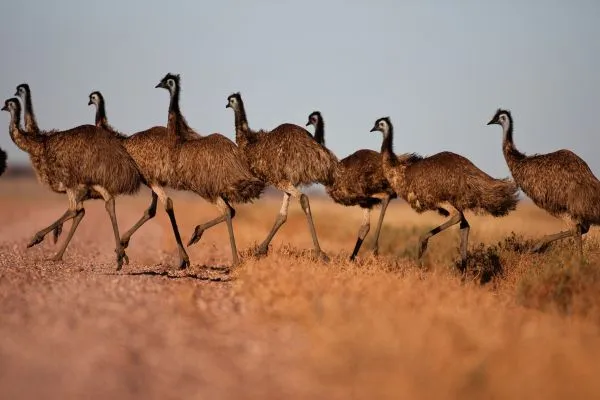
While familiar ratites such as ostriches, emus and cassowaries are flightless, one lesser-known family of ratites can fly, the South American tinamou. These tinamous were not ratites that rediscovered the ability to fly; rather, they had never lost it. This has helped scientists understand that the ancestors of this group of birds were once capable of flight but subsequently lost the ability, perhaps when dinosaurs became extinct.
Our new understanding that ratites’ ancestors were not flightless has solved the mystery of how they became dispersed around the world, over marine barriers. Find out more about flightless birds.
Find out more
Our experts have compiled a comprehensive guide to the southern cassowary, as well as the biggest birds.